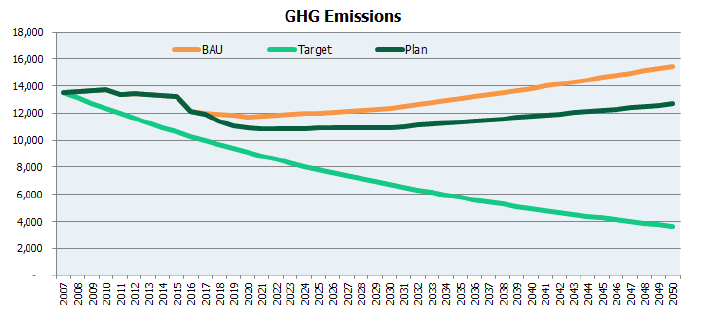Back in 2003, the municipality of Bowen Island worked with the Pembina Institute to determine the source of the community’s carbon emissions and how to reduce them. This past year, the Municipality, alongside representatives from a variety of community groups as well as interested members of the public revisited the data and came up with a new set of actions to reduce Bowen’s annual output of carbon emissions. If followed rigorously, these actions will leave Bowen’s emissions well above the desired target of roughly 4,000 tonnes of Green House Gas (GHG) emissions annually by 2050.
“My big take-away from this is that it is really difficult to make an impact,” says Municipal Councillor Maureen Nicholson, who alongside Councillor Sue Ellen Fast and head of bylaw services, Bonny Brokenshire, have shared the responsibility of leading the project. “When you look at the difference between business as usual and what the GHG emissions look like after the proposed changes, there is a very big gap. But you see the same kind of graphs at a provincial level. This underscores the importance of all three levels of government working together.”
Nicholson points to British Columbia’s updated Building Act as an example of the province opening up the possibility for municipalities to make a bigger impact on emissions.
“Municipalities can sign on to codes that require increased levels of energy efficiency of homes,” says Nicholson. “You can sign to meet the basic levels or higher levels but the impact on housing costs are a consideration on how far to go. Bowen Island has applied for a grant under the rural dividend program to develop a training and education program related to this – we would be able to bring in off-island expertise and help our contractors learn to work within these new regulations.”
However, Nicholson says, while in Vancouver building efficiency is the number one source of emissions, here on Bowen it is transportation.
“More than 80% of our emissions are related to transportation,” she says. “Many of those are related to the ferry and as a municipality we have no control over that.”
David Hocking, who is a member of the municipal Transportation Advisory Committee and participated in both the 2003 emissions plan and this creation of this recent plan, says the failure of the earlier plan related to things beyond Bowen Island’s control.
“The 2003 plan did not really make an impact,” he says. “But some of the suggested actions in that plan did eventually happen for other reasons and those have made an impact. The creation of the commuter bus to downtown is my big example. I’ve spoken to people who’ve dropped their cars or even sold their cars because of this bus, simply because it makes sense economically and from a lifestyle point of view.”
Hocking adds that the actions laid out in the current emissions reduction plan are great, and will positively impact the Bowen Island lifestyle.
“Many of these are things we are trying to achieve with the Integrated Transportation Master Plan,” he says. “But they are not enough. By far the greatest impact on our emissions comes from the ferry. We do not have emissions figures on the ferry crossings, but we do know those emissions have gone up since 2003. And as far as I can tell, BC Ferries does not even have an emissions plan, and that is a real problem.”
He says that while current water taxi services make a positive impact, better public transportation on the mainland is required to make it easier for people to leave their cars at home.
“Getting to the North Shore, say to Lion’s Gate Hospital or Capilano College, is really hard without a car,” says Hocking. “We need more options. I know that our councillors are working on improving transportation options when they talk to BC Ferries, TransLink and provincial representatives. This needs to continue, and individually, Bowen Islanders need to do what they can to get out of their cars.”
If you would like to read the Community Energy and Emissions Plan, you can find it attached to the council agenda from December 12. Councillors Maureen Nicholson and Sue Ellen Fast will be discussing the next steps of the implementation of the Community Energy Emissions plan on January 25 at 7pm, at the municipal hall.



